
(Detail from PBOT’s Portland Progress: A 2-Year Workplan.
The City of Portland has released a new plan aimed at re-energizing their Bureau of Transportation.
“We will be ambitious, and we will be accountable. We will move forward quickly and efficiently within two years to make this plan a reality.”
— Leah Treat, PBOT Director
Portland Progress: A 2-Year Workplan comes at a time when the bureau is suffering from stagnation, communications crises, the defeat of the Our Streets revenue push, and lack of a clear vision for the future (or a political champion to take them there).
In an introduction to the plan, PBOT Commissioner Steve Novick said it was needed because, “We need to revitalize the Bureau.”
PBOT Director Leah Treat has wanted to release a plan like this ever since taking over the bureau. During her job interview in June 2013, she told us that if she became director her first priority would be to, “stand up the agency from the bottom up and make sure that I have talent inside the agency… And to instill a sense of vision and mission with the agency and inspire each and every one of them to be excited about public service and what we do.”
As for how PBOT will move forward now that a politically-bruising push for new revenue is on hold, Novick said that the Portland Progress plan is, “a path forward with or without Our Streets revenue.”
The plan is split into five chapters…
And there’s a sixth section, Shoring Up the Foundation, meant to serve as an internal workplan to be used by agency staff.
Here’s the key summary of how the internal plan relates to the public plan:
“While the outward-facing workplan lays out the many actions and initiatives we will undertake in service to Portland residents and businesses, this workplan articulates what we will do to make our internal operations more effective. This service comes in many forms: a renewed commitment to training, better communication within the agency, more effective ways of telling the outside world what we do and the value of the services we provide. The workplan also includes improvements to internal processes and continued attention to financial planning and financial systems.”
Advertisement
When it comes to investing in staff, one of the actions listed in the plan is to expand and improve PBOT employee bike parking at their downtown and maintenance buildings. Another piece of the internal plan to keep our eye on is a promise to “evaluate the current interplay” between the Active Transportation, Traffic, and Signals divisions of the bureau.
Also in the internal plan, there’s an entire chapter on communications with goals listed to create a PBOT Communications Plan and a Public Involvement Plan. On that note, PBOT says they’ll hire a new “public involvement specialist.”
In the public-facing workplan, the meatiest chapter is on Vision Zero. We hinted a year ago that Treat would use this plan as a way to codify her commitment to Vision Zero, a belief that we should not tolerate any transportation deaths.
The plan lays out several ways PBOT will approach this lofty goal. They’ll use a mix of street design that focuses on the most vulnerable users, educating the public and strengthening driver education, and enforcement.
Here are a few of the specific promises/actions in the Vision Zero chapter that caught our eyes:
- Bike-Streetcar Safety: Develop and initiate research project for bike-streetcar safety.
- New/Updated Greenways: Complete a Neighborhood Greenways Assessment Report, which includes design and maintenance recommendations for five new or upgraded neighborhood greenways, by 2016.
- Central City Safety: Complete planning and begin project development for the Central City multimodal safety project.
- Experimental Speed Zone: In 2015, complete the development of an Experimental Speed Zone Process, a method that will enable PBOT to evaluate speed limits on some city streets, and submit to ODOT and the Oregon Speed Zone Panel for review and approval. If approved, implement the new process and initiate a comprehensive evaluation of speed zones on all collector and arterial streets in East Portland.
- Safe Routes Expansion: For school year 2014-2015, expand Safe Routes to Schools program to work with all public middle and elementary schools in the city. For 2016, explore expanding program into 10 high schools
- Vision Zero Plan: Complete a comprehensive Vision Zero plan. Every two-years, complete a 2-year safety report and dashboard.
- Targeted Safety Messaging: Select three specific audiences to target for safety messages each year and develop specific messages, outreach strategies, and metrics of effectiveness for each. Monitor existing and future safety programming and report on effects.
In the “Build The Future” chapter, we noted how PBOT applies the term “equity” to transportation: “What equity does mean, though, is having the same functionality, the same connectivity, the same opportunity to access the goods, services, and opportunities to enable individuals and communities to thrive.”
We’ve seen many plans from PBOT, and many people are no longer impressed until there’s action. Treat is promising to be accountable for this latest proclamation of “bold and audacious” goals. In a statement she said she plans to “move forward quickly and efficiently within two years to make this plan a reality.”
Time will tell.
Learn more and download the plan here.

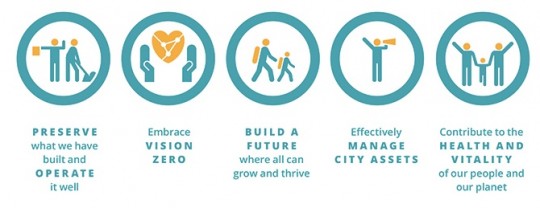
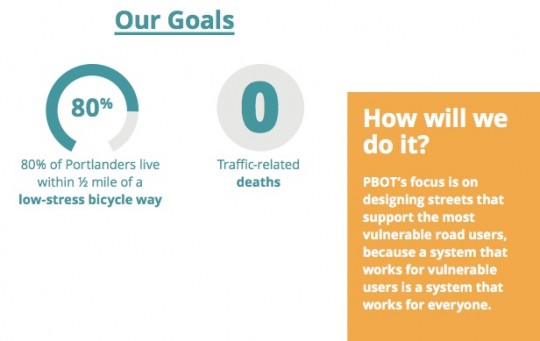
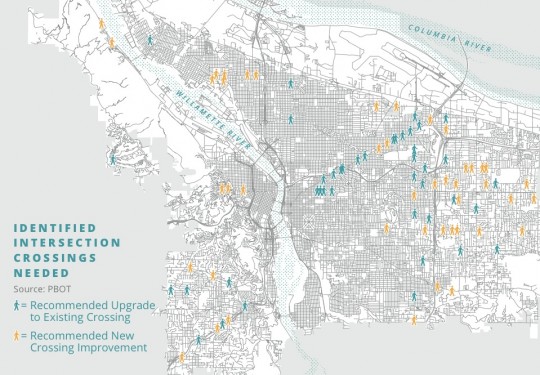


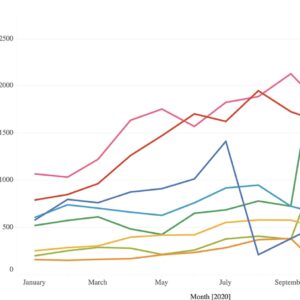
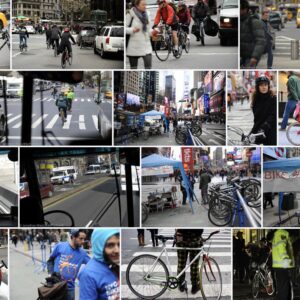
This is great news for Portlanders. I’m looking forward to seeing PBOT implement solutions to promote safety for everyone. I’d love to see an inter-connected system of protected bike lanes.
Define ‘protected’. How would we pay for that?
Protected means separated from car/truck traffic by either a curb, planters/bioswales, or other barrier. Paid for by taxes.
1. Lower all speed limits 10 mph.
2. Add a “zero” to all speeding fines
3. Give police direct cash comissions for speeding tickets and other life-endangering violations
4. Remember that the word “automobile” appears not one little time in the US Constitution.
Perfect is the enemy of good.
10 mph would apply to cyclists as well. A realistic goal would be based on data as presented in the Wramborg graph. 20 mph where autos and non-autos share a space. 25 mph if those two are separated by space or permeable barriers. max of 30 mph on any street with plain vanilla bike lanes. Max of 35 mph on any street approaching a major intersection without any other mitigations. Max of 45 on any street where head-on collisions are not prevented.
If you think goods are expensive now, consider how much they would cost if the trucks that deliver them never could go faster than 10 mph.
Commissions for work sounds like a recipe for graft.
How about convincing the DA and judges that 11 mph over the speed limit before a ticket is nuts. How about 6 mph, or 2 mph?
How about getting the State to lower the BAC for DUII to .04, or .02?
We’re mostly talking about state law then, but it should be done.
Lower the thresholds for class C,B,A speeding to be proportional (based on 55mph) in under-30 zone — say 4,8,12mph rather than 11,21,30.
Offer bike operator certification (optional — not licensing) and ability to bypass the DMV for your auto license if you have passed the bicycle on-road test. Really it should be a mandatory prereq to a driver’s license, but getting to skip the DMV would be a nice incentive to learn the bike rules and experience roads outside the box.
Traffic fines and BAC is a state issue.
Alternate speed zoning authority is something PBOT can ask for.
See OAR 734-020-015 (3) for the rules.
http://arcweb.sos.state.or.us/pages/rules/oars_700/oar_734/734_020.html
Be careful what you wish for, especially when it comes to empowering the police. Under your proposal you’d see a LOT more cops trapping red lights and stop signs to catch “those dangerous bicyclists who don’t come to a complete stop.” Among other things.
So stop at red lights and stop signs. Your legs aren’t noodles, and neither are you without muscles if you are riding. Stopping and starting again shouldn’t be outside of your skill set.
Cash incentives, to members of an organization that exhibits institutionalized racism from top to bottom every single day? No thanks.
Too much focus on Sandy and not enough on MLK Blvd. The Going Greenway crossing is a crucial connection but just awful to cross. Vegetated islands with poorly lit, poorly signed and poorly striped crossings running all up and down MLK. Many of which only have an after thought of a pedestrian warning sign (often obscured by trees) A slightly different color or grey marking a sidewalk is not a safety feature.
https://www.google.com/maps/@45.549319,-122.661528,3a,75y,354.46h,73.49t/data=!3m4!1e1!3m2!1sYz978a2d_SfEYMCWPgUU_g!2e0
I’ve witnessed more than one rear end collision because neither pedestrians nor cars knew what what going on
totally agree SuWanda! When they were planning this, the project manager agreed that the best and natural route for the Going to the River was to use Skidmore between Interstate and either 6th or 7th- except it would require removing parking. Skidmore has all the needed traffic signals, it would just take a little political willpower to create a MUCH safer and easier to use greenway.
Skidmore west of MLK is a Neighborhood Collector and Major Emergency Response route. Difficult roads in the best of circumstances to repurpose for safe bike use.
Skidmore at 15th is downhill from a signal where motorists gain speed.
At 33rd its a bit of a jog, maybe twice the cost of the Going cycle track.
Unimproved at 52nd.
Plus, the Going route was a community initiated route.
paikala,
I agree that creating a safe and inviting bike route along a Neighborhood Collector could prove difficult, but generous, protected bike lanes could be added to Skidmore between MLK and Michigan (they already exist between Michigan and Interstate) by re-purposing the underused on-street parking. I think you may have misunderstood my comment; to clarify: I love the Going greenway except the west end. If the route could be shifted to Skidmore between Interstate Ave and NE 6th, I think the route would be greatly improved in terms of safety, navigability, and connectivity.
Parking on Skidmore from Williams to Mississippi is sparse. Taking one side of auto parking would be a fantastic idea. Right now the only E/W option for me is Blandena, fairly untraveled by cars. But then you have the I-5 crossing at Alberta which is easily hell at rush hours and beyond. Alberta/Michigan diverter would solve constant cut-throughs down Michigan, and a Skidmore bike lane would be an E/W connection I would definitely use. Instantly, my commute turns from consistent, expected and unavoidable stress, to la de da.
Taking one side of parking would get you 8 feet. 2 bike lanes in 8 feet?
Have you contacted 823-SAFE regarding specific locations and specific concerns, with suggested improvements?
there are six traffic engineers for the entire city working on corrections to the operation of the current system, and currently over 160 requests in the queue.
Your link is to Beech at MLK, a wide open intersection with illumination, contrary to your complaint. PBOT no longer marks multi-lane crossings unless at least rapid flash beacons can be also built. Each crossing with a median would get 3 poles and cost about $40,000 to upgrade. So to do both crossings at Beech would be $80k.
MLK at Going seems to have most of what you ask for:
http://goo.gl/maps/8yuec
BTW, those medians help to slow down motorists, prevent head-on collisions, and provide a refuge space for pedestrians so they only have to focus on one direction of traffic at a time. Many people on as busy of streets in Portland wish for such amenities.
Interesting to hear this, I have had fantastic experiences crossing here and now I prefer it compared to the busier signalized crossings. I really enjoy how often people driving stop and allow folks to cross here – on busy MLK! A lot of that has to do with the design of the crossing and the crosswalk / crossbike visbility.
I cross MLK at Going Street quite often, and I agree: I’ve had very little trouble being seen. In fact, I’m always kind of surprised to find drivers stopping for me, on foot or on my bike.
how about a hwy sign that ppl have to read as they speed past, maybe it might sink in within all cities within Oregon. 🙂
saying what? I missed your point.
“Kill Your Car“
No way man. I love my WRX.
I’d rather have my LHT. 😉
“a political champion to take them there”. A group like BikeLoud, expanded to be more inclusive of pedestrian and transit users, or a coalition of such like minded groups, could refocus neighborhood energy behind VZ and give it the political clout to focus elected’s on what needs to be done.
I heard the news via OPB…BUT the reporter used the word “accident” in today’s report. Arggggh!!!!
If the City leaders cannot communicate this topic past one point of contact then its really doomed unless they double down on the education of the press and others.
I remain optimistic that these tasty projects will be served up soon. But I also think that as much as cool new initiatives are important, screwy existing ones need to be retired or seriously revamped:
http://bikeportland.org/2014/06/20/pbot-ad-campaign-drivers-slow-107630
Brochure that focuses on pedestrian’s actions rather than drivers’
http://bikeportland.org/2014/06/24/city-proposes-30000-project-preserve-street-parking-next-unused-parking-lot-107793
A $30,000 curb relocation to make room for extra parking for Katie O’Brien’s gout-stricken patrons
http://bikeportland.org/2014/04/25/parking-power-prevails-for-now-pbot-pulls-plug-on-28th-ave-bike-lanes-105104
PBOT caves to 28th St. businesses who think their customers all drive
http://bikeportland.org/2013/10/24/after-tempers-flare-citizen-committee-approves-pbots-plans-for-foster-96054
PBOT loses nerve connecting Foster bikeway to 52nd; expects bikey folks to ‘weave through the neighborhood’ instead.
Because without breaking with this inauspicious pattern of caving to the auto-interests, sticking it to the pedestrians, losing their nerve again and again when it comes to human powered infrastructure decisions, I see zero hope for this Vision.
I have no doubt that all parties involved genuinely mean it, and it is certainly a step in the right direction, but it’s a pretty small step. Or, rather, it is huge and truly fantastic… just not enough. It is going to take a lot more than imagination, education, and a handful of infrastructure changes.
And can we please stop talking about “vulnerable” road users? It’s an offensive term. The only reason I am vulnerable is because I’m surrounded by armed maniacs. How about we place the focus on reckless and dangerous road users instead?
One of the issues I see with the PBOT movement on VZ/Safe Systems is that it is coming from inside PBOT. While it is PBOT’s job, the policy won’t get much traction unless portlanders demand change and the political leaders lead.
Maybe it’s ’cause I’m not a Portlander (and BTW, the link to the doc is broken – missing the http://at the front) — but did anyone else read the full report?
You realize 99% of American livable streets activists would kill to have their city staff writing something that so fundamentally gets the value of multimodal thinking, and the importance of walking and bicycling?
Link above is broken, this works:
https://www.portlandoregon.gov/transportation/66470
Look, I know most police depts. including Portlands are a bunch racist gangsters; but all this “Zero” talk is just hot air unless we are willing to allow the authorities to introduce some fear of consequences into the lives of drivers. I know this ain’t real Kumbaya, but my 45 years of cycling tells me it’s the truth and there’s ultimately no avoiding it.
Where VZ/Safe Systems has worked best, Western Europe and Australia, the concept was more top down, from the National level, and also mostly in political systems that incentivize reductions in death. The US system is not like that. When the Federal Government can put a societal dollar value on a person’s life ($6M), you know the system is willing to trade lives for efficiency.
The VZ/Safe Systems model begins with the premise that road users will make mistakes. The solutions to fixing the outcome so that fatalities are minimized are outlined in a Haddon matrix. Road design, vehicle design, road user knowlege and skills, laws, enforcement, ajudication and trauma care are all aspects that need to be collectively rallied and improved for VZ to come close to achieving in the US what has been achieved elsewhere.